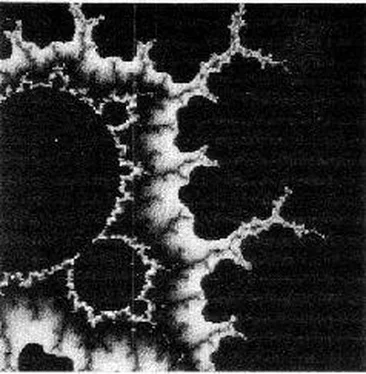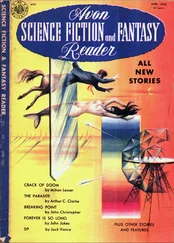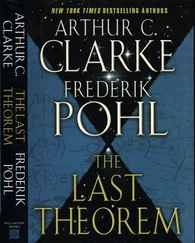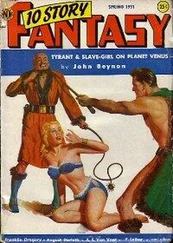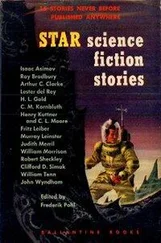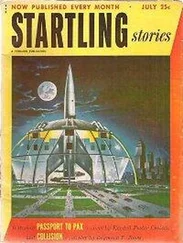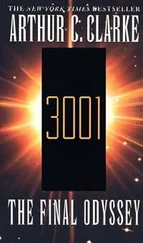“S for squaring?”
“Of cour—Yes. Now, here’s the important point. The numbers on either side are totally separated; yet though nothing can pass through it, the boundary hasn’t any thickness. It’s simply a line—you could go on magnifying it forever and it would stay a line, though it would soon appear to be a straight one because you wouldn’t be able to see its curvature.”
“This may not seem very exciting,” interjected Donald, “but it’s absolutely fundamental—you’ll soon see why—sorry, Ada.”
“Now, to get the M-Set we make one teeny- weeny change. We don’t just square the numbers. We square and add … square and add . You wouldn’t think it would make all that difference—but it opens up a whole new universe…
“Suppose we start with one again. We square it and get one. Then we add them to get two.
“Two squared is four. Add the original one again—answer five.
“Five squared is twenty-five—add one—twenty-six.
“Twenty-six squared is six hundred seventy-six—you see what’s happening! The numbers are shooting up at a fantastic rate. A few more times around the loop, and they’re too big for any computer to handle. Yet we started with— one ! So that’s the first big difference between the M-Set and the S-set, which has its boundary at one.
“But if we started with a much smaller number than one—say zero point one—you’ll probably guess what happens.”
“It collapses to nothing after a few cycles of squaring and adding.”
Ada gave her rare but dazzling smile.
“ Usually. Sometimes it dithers around a small, fixed value—anyway, it’s trapped inside the set. So once again we have a map that divides all the numbers on the plane into two classes. Only this time, the boundary isn’t something as elementary as a circle.”
“You can say that again,” murmured Donald. He collected a frown from Edith, but pressed on. “I’ve asked quite a few people what shape they thought would be produced; most suggested some kind of oval. No one came near the truth; no one ever could. All right, Lady! I won’t interrupt Ada again!”
“Here’s the first approximation,” continued Ada, scooping up her boisterous puppy with one hand while tapping the keyboard with the other. “You’ve already seen it today.”
The now-familiar outline of Lake Mandelbrot had appeared superimposed on the grid of unit squares, but in far more detail than Bradley had seen it in the garden. On the right was the largest, roughly heart-shaped figure, then a smaller circle touching it, a much smaller one touching that —and the narrow spike running off to the extreme left and ending at—2 on the x-axis.
Now, however, Bradley could see that the main figures were barnacled—that was the metaphor that came instantly to mind—with a myriad of smaller subsidiary circles, many of which had short jagged lines extending from them. It was a much more complex shape than the pattern of lakes in the garden—strange and intriguing, but certainly not at all beautiful. Edith and Ada, however, were looking at it with a kind of reverential awe, which Donald did not seem to entirely share.
“This is the complete set with no magnification,” said Ada, in a voice that was now a little less self-assured—in fact, almost hushed.
“Even on this scale, though, you can see how different it is from the plain, zero-thickness circle bounding the S-set. You could zoom that up forever and ever, and it would remain a line—nothing more. But the boundary of the M-Set is fuzzy —it contains infinite detail: you can go in anywhere you like, and magnify as much as you please—and you’ll always discover something new and unexpected—look!”
The image expanded; they were diving into the cleft between the main cardioid and its tangent circle. It was, Bradley told himself, very much like watching a zip-fastener being pulled open—except that the teeth of the zipper had the most extraordinary shapes.
First they looked like baby elephants, waving tiny trunks. Then the trunks became tentacles. Then the tentacles sprouted eyes. Then, as the image continued to expand, the eyes opened up into black whirlpools of infinite depth…
“The magnification’s up in the millions now,” Edith whispered. “The picture we started with is already bigger than Europe.”
They swept past the whirlpools, skirting mysterious islands guarded by reefs of coral. Flotillas of seahorses sailed by in stately procession. At the screen’s exact center, a tiny black dot appeared, expanded, began to show a haunting familiarity—and seconds later revealed itself as an exact replica of the original set.
This, Bradley thought, is where we came in. Or is it? He could not be quite sure; there seemed to be minor differences, but the family resemblance was unmistakable.
“Now,” continued Ada, “our original picture is as wide as the orbit of Mars—so this mini-set’s really far smaller than an atom. But there’s just as much detail all around it. And so on forever.”
The zooming stopped; for a moment it seemed that a sample of lacework, full of intricate loops and whorls that teased the eye, hung frozen in space. Then, as if a paintbox had been spilled over it, the monochrome image burst into colors so unexpected, and so dazzlingly beautiful, that Bradley gave a gasp of astonishment.
The zooming restarted, but in the reverse direction, and in a micro-universe now transformed by color. No one said a word until they were back at the original complete M-Set, now an ominous black fringed with a narrow border of golden fire, and shooting off jagged lightnings of blues and purples.
“And where,” asked Bradley when he had recovered his breath, “did all those colors come from? We didn’t see them on the way in.”
Ada laughed. “No—they’re not really part of the set—but aren’t they gorgeous? I can tell the computer to make them anything I like.”
“Even though the actual colors are quite arbitrary,” Edith explained, “they’re full of meaning. You know the way map makers put shades of blue and green between contour lines, to emphasize differences in level?”
“Of course; we do just the same thing in oceanography. The deeper the blue, the deeper the water.”
“Right. In this case, the colors tell us how many times the computer’s had to go around the loop before it decides whether a number definitely belongs to the M-Set—or not. In borderline cases, it may have to do the squaring and adding routine thousands of times.”
“And often for hundred-digit numbers,” said Donald. “ Now you understand why the set wasn’t discovered earlier.”
“Mighty good reason.”
“Now watch this,” said Ada.
The image came to life as waves of color flowed outward. It seemed that the borders of the set itself were continually expanding—yet staying in the same place. Then Bradley realized that nothing was really moving; only the colors were cycling around the spectrum, to produce this completely convincing illusion of movement.
I begin to understand, Bradley thought, how someone could get lost in this thing—even make it a way of life.
“I’m almost certain,” he said, “that I’ve seen this program listed in my computer’s software library—with a couple of thousand others. How lucky I’ve never run it. I can see how addictive it could get.”
He noticed that Donald Craig glanced sharply at Edith, and realized that he had made a somewhat tactless remark. However, she still seemed engrossed by the flow of colors, even though she must have seen this particular display countless times.
“Ada,” she said dreamily, “give Mr. Jason our favorite quotation from Einstein.”
Читать дальше
